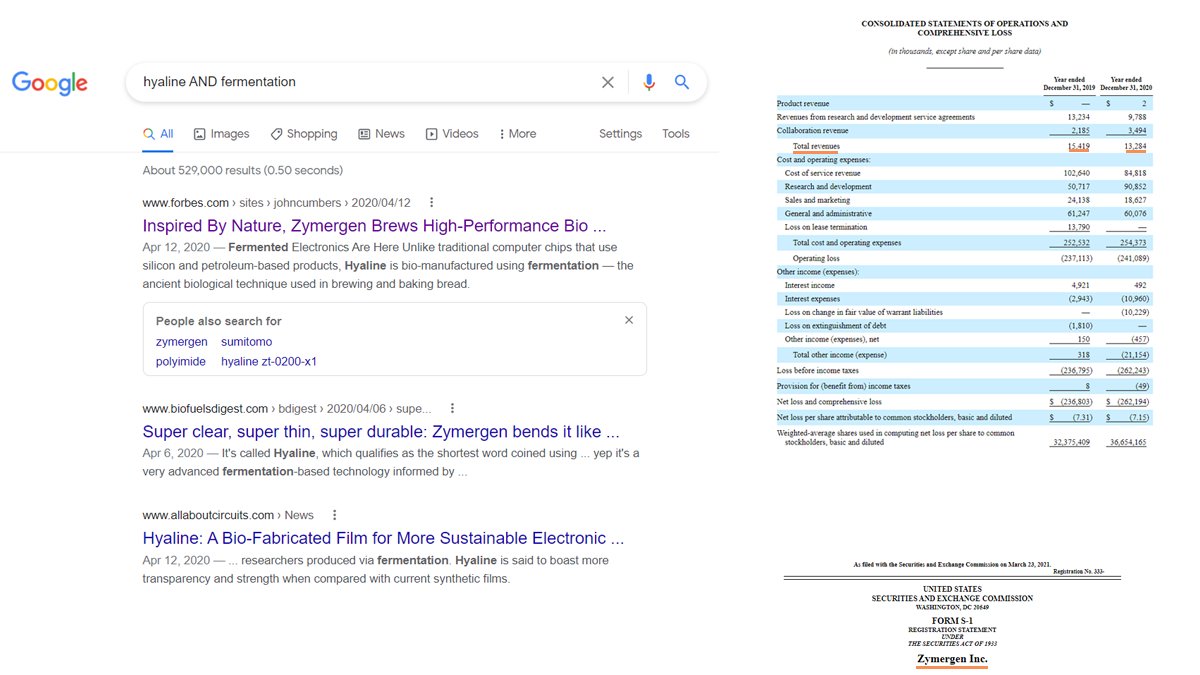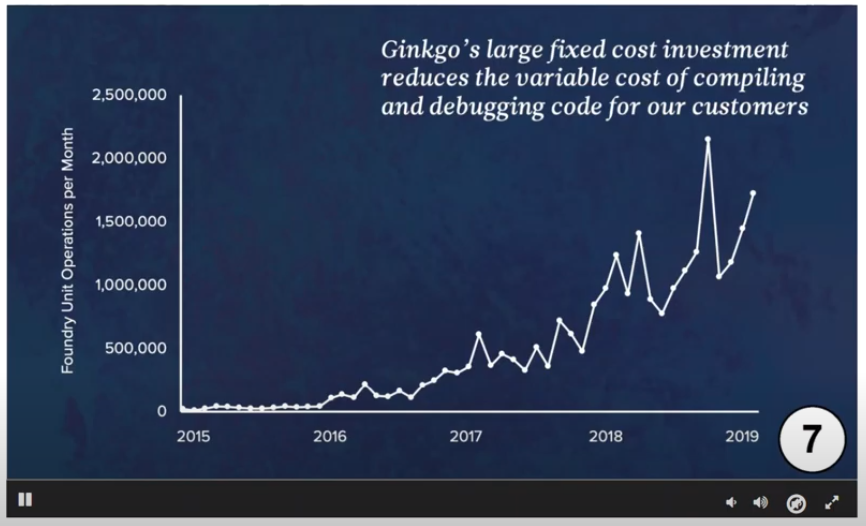
S-1 thread
@Zymergen( $ZY) surprised today w $100M Initial Public Offering. JPM, GS, BOA, Cowen
Last valued $1.75B
Word counts
"biofactur-": 173
Hyaline:140
"Nature" (capital N):39
#SyntheticBiology/#SynBio:26
#MachineLearning:24
@Amyris ( $AMRS):2
@Ginkgo:0
@Intrexon (RIP):0
@Zymergen( $ZY) surprised today w $100M Initial Public Offering. JPM, GS, BOA, Cowen
Last valued $1.75B
Word counts
"biofactur-": 173
Hyaline:140
"Nature" (capital N):39
#SyntheticBiology/#SynBio:26
#MachineLearning:24
@Amyris ( $AMRS):2
@Ginkgo:0
@Intrexon (RIP):0
https://twitter.com/Varro_Analytics/status/1303468138072285184

S-1 bit.ly/31b1qhl
$13M in R&D/collab revenue in 2020
$ZY spent "5 years & $50 million" to "launch" (w/o product rev) lead product Hyaline (electronic screen film)
Early version made w chem synthesis, NOT fermentation (#synbio), but plans to ferment later (lower COGS)



$13M in R&D/collab revenue in 2020
$ZY spent "5 years & $50 million" to "launch" (w/o product rev) lead product Hyaline (electronic screen film)
Early version made w chem synthesis, NOT fermentation (#synbio), but plans to ferment later (lower COGS)




^Hyaline chem synth underscores challenge of $ZY's biz model
$ZY trying to simultaneously design/build/test organisms AND market end products
Chem synth gets products into customer hands earlier than $XON/ $AMRS, but might improve top-line focusing on design/build/test w JV's
$ZY trying to simultaneously design/build/test organisms AND market end products
Chem synth gets products into customer hands earlier than $XON/ $AMRS, but might improve top-line focusing on design/build/test w JV's

^ Benefit of a #synbio company creating a joint venture (JV) w a Fortune500 company is that it doesn't have to focus on selling end products. Then the #synbio co can focus its human & financial capital on its core competency (engineering microbes), and still share in risk/reward
^ By specializing in being a "go-to" #synbio intellectual property "fab" with JV model, it can also rack up more revenue-generating deals and satisfy investors
Fortune500 co's also recognize how disruptive #synbio already is in disrupting supply chains, and will pay to get ahead
Fortune500 co's also recognize how disruptive #synbio already is in disrupting supply chains, and will pay to get ahead
There is also a Perceptive Advisors debt covenant subplot that was not apparent until $ZY filing
Had previously just assumed Perceptive only held $ZY equity
The Sept 2020 press release made mention of "growth financing" from Perceptive
prnewswire.com/news-releases/…
Had previously just assumed Perceptive only held $ZY equity
The Sept 2020 press release made mention of "growth financing" from Perceptive
prnewswire.com/news-releases/…

^ Sept 2020 Perceptive / $ZY "growth financing" was actually $100M credit facility
By YE20, $ZY was unable to comply w debt covenant, but got waiver
If $ZY defaults, Perceptive gets "SUBSTANTIALLY ALL assets, including IP"
So $ZY has an immediate interest in doing a $100M IPO
By YE20, $ZY was unable to comply w debt covenant, but got waiver
If $ZY defaults, Perceptive gets "SUBSTANTIALLY ALL assets, including IP"
So $ZY has an immediate interest in doing a $100M IPO

^ The $ZY S-1 document makes it clear that at least a portion of the $100M offering proceeds will go towards the Perceptive credit facility
$AMRS $XON
#SynBio
$AMRS $XON
#SynBio

$ZY priced at around $3B cap
97,450,901 shares * $31
$31 was the high end
#SynBio
$AMRS $CDXS $NVZMY $ABCL
$TWST $BLI

97,450,901 shares * $31
$31 was the high end
#SynBio
$AMRS $CDXS $NVZMY $ABCL
$TWST $BLI
https://twitter.com/IPOBoutique/status/1385181193541464069

• • •
Missing some Tweet in this thread? You can try to
force a refresh











